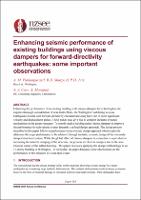Enhancing seismic performance of existing buildings using viscous dampers for Forward-Directivity Earthquakes – The Challenges

Download
Date
2021-04-14Authors
Puthanpurayil, Arun
Sharpe, Richard
Jury, Rob
Carr, Athol
Murahidy, Alex
Metadata
Show full item recordAbstract
Enhancing the performance of an existing building with viscous dampers for a Wellington site requires thorough consideration of near-fault effects, the Wellington Fault being so close. Earthquake records with forward-directivity characteristics may have one or more significant velocity and displacement pulses. These pulses may give rise to complex inelastic dynamic mechanisms in the parent structure. To retrofit such a building using viscous dampers to improve the performance in such seismic events demands a refined design approach. The design process described in this paper follows a performance-based seismic design approach which explicitly addresses the target performance to be achieved through inelastic dynamic design of the viscously-damped structural system. While the global effect of viscous dampers in a structure is equivalent to increasing the inherent damping of the structure, the process involved is complex due to the non-classical nature of the added damping. This paper discusses applying this design methodology to an 11-storey building in Wellington. In particular, the paper discusses some observations on the performance of the structure in a near-fault event.
